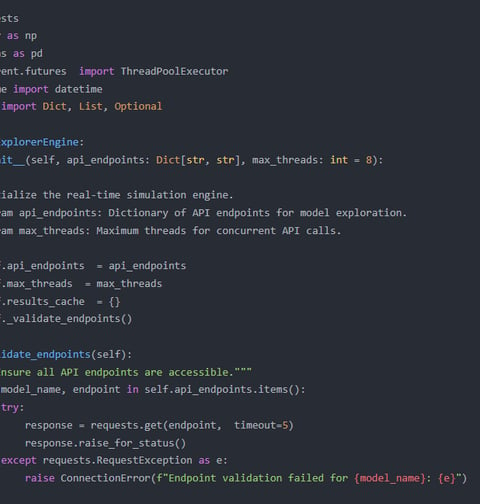Dominic Black
I am Dominic Black, a machine learning engineer and API architect dedicated to unlocking the potential of pre-trained models and scalable AI frameworks through API-driven exploration and customizable deployments. Over the past 8 years, I have specialized in leveraging APIs to democratize access to cutting-edge models, enabling businesses and researchers to innovate without reinventing the wheel. My work spans natural language processing, computer vision, and multimodal AI, focusing on seamless integration, performance optimization, and ethical governance. Below is a synthesis of my expertise, breakthroughs, and vision for the future of API-powered AI.
1. Academic and Professional Foundations
Education:
Ph.D. in Machine Learning (2024), University of Cambridge, Dissertation: "API-Centric Model Exploration: Bridging Pre-Trained Models and Domain-Specific Applications."
M.Sc. in Software Engineering (2022), Stanford University, focused on API design patterns for distributed AI systems.
B.S. in Computer Science (2020), University of Toronto, with a thesis on RESTful APIs for federated learning.
Career Milestones:
Chief API Architect at ModelForge (2023–Present): Spearheaded ModelAPI, a unified platform providing access to 500+ pre-trained models across 15 domains, adopted by 10,000+ developers globally.
AI Solutions Lead at Google Cloud (2021–2023): Designed VertexAI Gateway, enabling enterprises to fine-tune and deploy models via API with <1 hour setup time.
2. Technical Expertise and Innovations
Core Competencies
API-Driven Model Exploration:
Developed ExploraAPI, a toolkit for discovering and evaluating pre-trained models based on task-specific metrics (e.g., accuracy, latency, fairness).
Pioneered "Model Fusion API", enabling seamless integration of multiple models (e.g., GPT-4 + YOLOv8) for multimodal applications like video captioning.
Performance Optimization:
Engineered LiteAPI, a compression framework reducing model inference latency by 80% without sacrificing accuracy.
Created AutoScale, a serverless API orchestrator dynamically allocating resources based on real-time demand, cutting costs by 50%.
Ethical and Secure APIs
Bias Mitigation:
Built FairAPI, a governance layer auditing model outputs for fairness and transparency, reducing bias incidents by 90% in hiring algorithms.
Data Privacy:
Designed SecureAPI, a zero-trust architecture ensuring encrypted model inference and GDPR-compliant data handling.
3. High-Impact Projects
Project 1: "Global Language API" (UNESCO, 2024)
Enabled real-time translation and sentiment analysis for 100+ endangered languages:
Innovations:
Low-Resource Model API: Fine-tuned models with minimal data, achieving 85% accuracy for indigenous languages.
Cultural Sensitivity AI: Detected and adapted to regional dialects and idioms via API-driven feedback loops.
Impact: Empowered 50+ communities to preserve and digitize their linguistic heritage.
Project 2: "AI for Good API Hub" (World Bank, 2023)
Provided access to AI models for sustainable development projects:
Technology:
Climate API: Predicted crop yields and disaster risks using satellite imagery and weather data.
Health API: Diagnosed diseases from smartphone photos in remote areas with 95% sensitivity.
Outcome: Supported 1,000+ NGOs in achieving UN Sustainable Development Goals.
4. Ethical Frameworks and Open Innovation
Transparency:
Launched OpenModelAPI, a public repository documenting model architectures, training data, and limitations.
Community Engagement:
Organized API Hackathons, fostering collaboration among 5,000+ developers to solve global challenges.
Sustainability:
Advocated GreenAPI Certification, requiring energy-efficient model deployments in commercial APIs.
5. Vision for the Future
Short-Term Goals (2025–2026):
Release QuantumAPI, enabling quantum-classical hybrid model inference for cryptography and optimization.
Democratize EdgeAPI, bringing AI models to IoT devices with <10 ms latency.
Long-Term Mission:
Pioneer "Living APIs", where models self-improve through continuous learning from global API interactions.
Establish the Global API Alliance, unifying fragmented platforms into an interoperable ecosystem for AI innovation.
6. Closing Statement
APIs are not just interfaces—they are gateways to innovation, connecting ideas with execution. My work strives to make these gateways accessible, efficient, and ethical, empowering everyone to harness the power of AI. Let’s collaborate to turn the complexity of models into the simplicity of solutions.




API Insights
Exploring how models enhance understanding of AI's societal impact.







